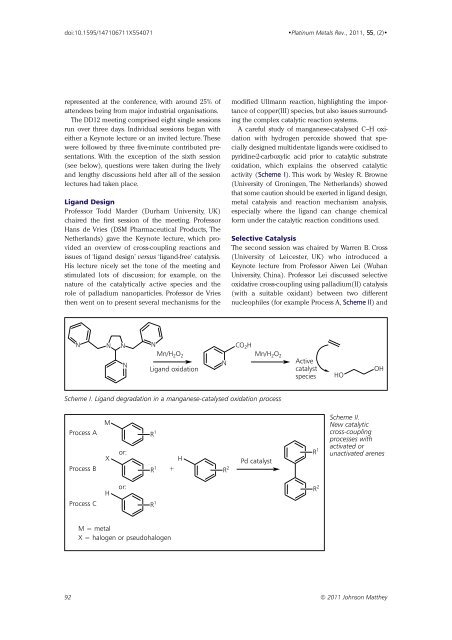Download - Platinum Metals Review
Download - Platinum Metals Review
Download - Platinum Metals Review
You also want an ePaper? Increase the reach of your titles
YUMPU automatically turns print PDFs into web optimized ePapers that Google loves.
doi:10.1595/147106711X554071<br />
•<strong>Platinum</strong> <strong>Metals</strong> Rev., 2011, 55, (2)•<br />
represented at the conference, with around 25% of<br />
attendees being from major industrial organisations.<br />
The DD12 meeting comprised eight single sessions<br />
run over three days. Individual sessions began with<br />
either a Keynote lecture or an invited lecture. These<br />
were followed by three five-minute contributed presentations.<br />
With the exception of the sixth session<br />
(see below), questions were taken during the lively<br />
and lengthy discussions held after all of the session<br />
lectures had taken place.<br />
Ligand Design<br />
Professor Todd Marder (Durham University, UK)<br />
chaired the first session of the meeting. Professor<br />
Hans de Vries (DSM Pharmaceutical Products, The<br />
Netherlands) gave the Keynote lecture, which provided<br />
an overview of cross-coupling reactions and<br />
issues of ‘ligand design’ versus ‘ligand-free’ catalysis.<br />
His lecture nicely set the tone of the meeting and<br />
stimulated lots of discussion; for example, on the<br />
nature of the catalytically active species and the<br />
role of palladium nanoparticles. Professor de Vries<br />
then went on to present several mechanisms for the<br />
modified Ullmann reaction, highlighting the importance<br />
of copper(III) species, but also issues surrounding<br />
the complex catalytic reaction systems.<br />
A careful study of manganese-catalysed C–H oxidation<br />
with hydrogen peroxide showed that specially<br />
designed multidentate ligands were oxidised to<br />
pyridine-2-carboxylic acid prior to catalytic substrate<br />
oxidation, which explains the observed catalytic<br />
activity (Scheme I). This work by Wesley R. Browne<br />
(University of Groningen, The Netherlands) showed<br />
that some caution should be exerted in ligand design,<br />
metal catalysis and reaction mechanism analysis,<br />
especially where the ligand can change chemical<br />
form under the catalytic reaction conditions used.<br />
Selective Catalysis<br />
The second session was chaired by Warren B. Cross<br />
(University of Leicester, UK) who introduced a<br />
Keynote lecture from Professor Aiwen Lei (Wuhan<br />
University, China). Professor Lei discussed selective<br />
oxidative cross-coupling using palladium(II) catalysis<br />
(with a suitable oxidant) between two different<br />
nucleophiles (for example Process A, Scheme II) and<br />
N<br />
N<br />
N<br />
N<br />
CO 2 H<br />
N<br />
Mn/H 2 O 2<br />
Ligand oxidation<br />
N<br />
Mn/H 2 O 2<br />
Active<br />
catalyst<br />
species<br />
HO<br />
OH<br />
Scheme I. Ligand degradation in a manganese-catalysed oxidation process<br />
Process A<br />
Process B<br />
M<br />
X<br />
or:<br />
R 1<br />
R 1<br />
+<br />
H<br />
R 2<br />
Pd catalyst<br />
R 1<br />
Scheme II.<br />
New catalytic<br />
cross-coupling<br />
processes with<br />
activated or<br />
unactivated arenes<br />
Process C<br />
H<br />
or:<br />
R 1<br />
R 2<br />
M = metal<br />
X = halogen or pseudohalogen<br />
92 © 2011 Johnson Matthey
















